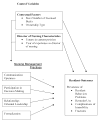Nursing homes as complex adaptive systems: relationship between management practice and resident outcomes
- PMID: 12552171
- PMCID: PMC1993902
- DOI: 10.1097/00006199-200301000-00003
Nursing homes as complex adaptive systems: relationship between management practice and resident outcomes
Abstract
Background: Despite numerous clinical and regulatory efforts, problems of poor quality of care in nursing homes continue, suggesting a need for effective management practices.
Objective: To test complexity hypotheses about the relationship between management practices (communication openness, decision making, relationship-oriented leadership, and formalization) and resident outcomes (aggressive behavior, restraint use, immobility of complications, and fractures), while controlling for case mix, size, ownership, and director's tenure and experience.
Method: A cross-sectional correlational field study design was used. Primary data were obtained from directors of nursing and registered nurses employed in 164 Texas nursing homes. Investigators administered self-report surveys onsite. Secondary data were obtained from 1995 Medicaid Cost Reports and the Texas nursing home Minimum Data Set (MDS) and were linked to primary data using a unique identifier.
Results: Hypotheses were supported in that each management practice explained one or more of the resident outcomes. Larger size and longer director of nursing tenure and experience also explained better resident outcomes. Predictors explained 11% ñ 21% of the variance.
Discussion: Complexity science was used to explain the results. The findings open the door to rethinking nursing home management practice. Practices that increase communication and interaction among people are needed for better resident outcomes.
Figures


References
-
- Aaronson WE, Zinn JS, Rosko MD. Do for-profit and not-for-profit nursing homes behave differently? Gerontologist. 1994;34(6):775–786. - PubMed
-
- Alexander JW. The effects of patient care unit organization on nursing turnover. Health Care Management Review. 1988;13(2):61–72. - PubMed
-
- Anderson, R. A., Ashmos, D. P., McDaniel, R. R., & Hsieh, P. C. (1997). Complexity theory view of participation in decision making: Conceptual and empirical analysis. Paper presented at the Proceedings 1997 Academy of management Annual Meeting, Boston MA.
-
- Anderson RA, ssel LM, McDaniel RRJ. Nursing staff turnover in nursing homes: A new look. Public Administration Quarterly. 1997;21(1):69–95.
Publication types
MeSH terms
Grants and funding
LinkOut - more resources
Full Text Sources
Medical
Research Materials
Miscellaneous

